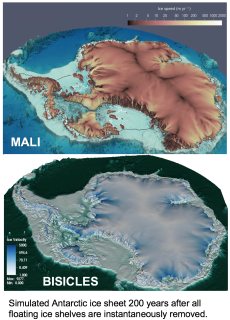DOE Models Simulate Antarctic Ice Sheet Evolution
Scientific Achievement
Ice sheet models developed under a DOE SciDAC project and run at NERSC have contributed to three international model intercomparison projects focused on assessing the future evolution of the Antarctic ice sheet.
Significance and Impact
Results from one experiment, shown at right, provide an upper-bound estimate for the potential sea-level rise from Antarctica resulting from the rapid and sustained loss of all floating ice shelves. This process triggers the marine ice sheet instability, which is currently one of the largest sources of uncertainty in future sea-level projections.
Research Details
DOE’s simulation results represent the highest resolution and highest fidelity simulations contributed to the project. Optimization methods are used to initialize DOE’s MALI and BISICLES ice sheet models to match present-day observations. An extreme (and unrealistic) perturbation is then applied by instantaneously removing all of Antarctica’s floating ice shelves. This triggers immediate, continuous, and unstable retreat of marine sectors of the ice sheet. The simulations used 10s of millions of hours on NERSC computers.
Related Links
DOE SciDAC ProSPect: https://doe-prospect.github.io/
MALI model description paper: https://www.geosci-model-dev.net/11/3747/2018/
BISICLES model description paper: https://www.sciencedirect.com/science/article/pii/S0021999112005050?via=ihub
MALI model highlight flyer: https://e3sm.org/wp-content/uploads/2019/01/TechnicalHighlight_MALI.pdf
BISICLES model highlight flyer: https://e3sm.org/wp-content/uploads/2018/08/ResearchHighlight_BISICLES.pdf
About NERSC and Berkeley Lab
The National Energy Research Scientific Computing Center (NERSC) is a U.S. Department of Energy Office of Science User Facility that serves as the primary high performance computing center for scientific research sponsored by the Office of Science. Located at Lawrence Berkeley National Laboratory, NERSC serves almost 10,000 scientists at national laboratories and universities researching a wide range of problems in climate, fusion energy, materials science, physics, chemistry, computational biology, and other disciplines. Berkeley Lab is a DOE national laboratory located in Berkeley, California. It conducts unclassified scientific research and is managed by the University of California for the U.S. Department of Energy. »Learn more about computing sciences at Berkeley Lab.








